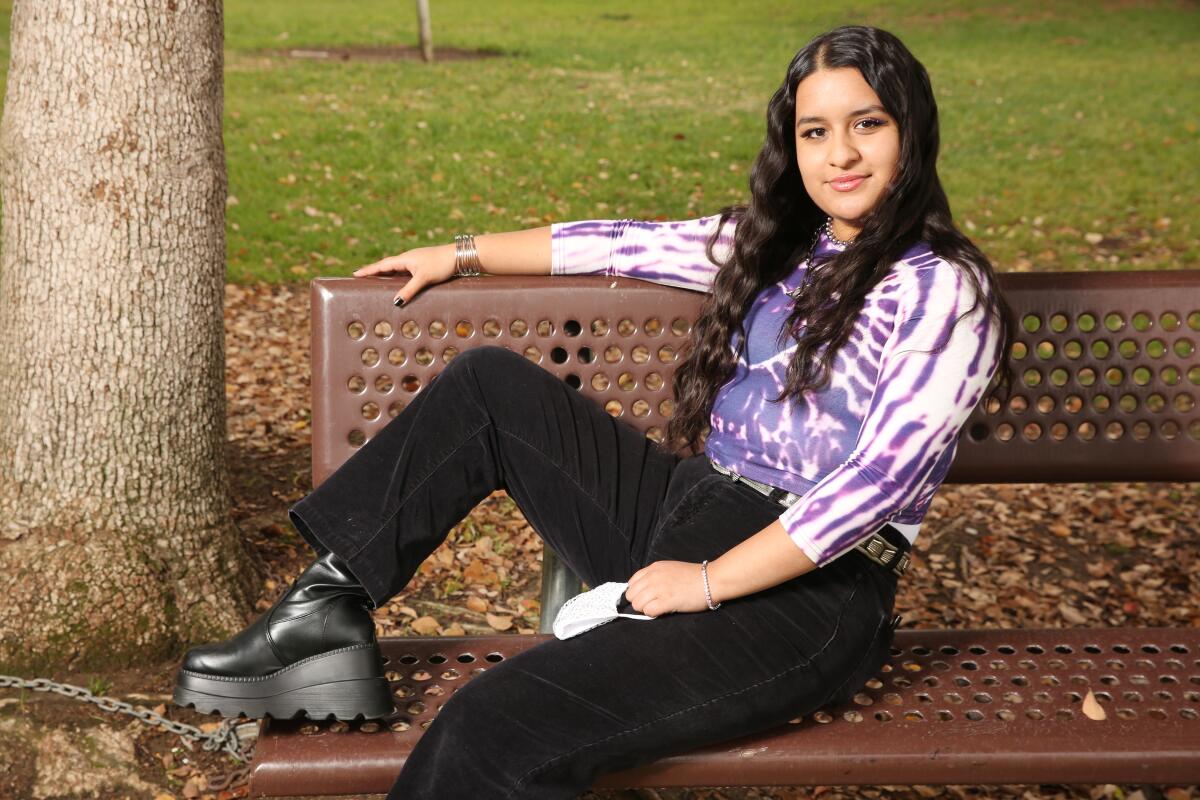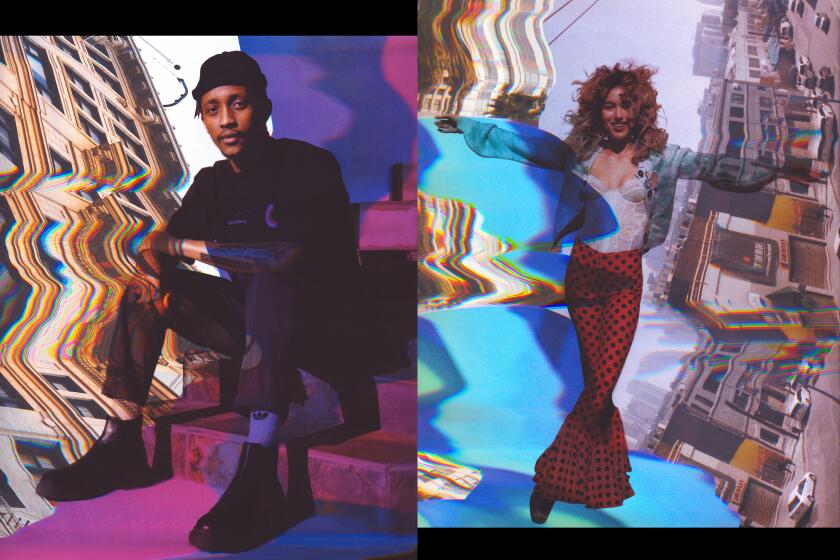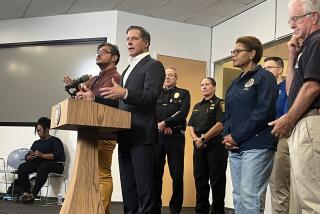No more pajamas: Back-to-school fashion gives students a sense of hope after pandemic

Like many L.A. teens, 17-year-old Sheccid Vazquez spent the last year in pajamas.
“During quarantine, I would wake up and stay in my pajamas until the end of school,” said the Ramona Convent Secondary School senior. “I wouldn’t change because teachers gave us the option not to turn our cameras on.”
But with high school campuses reopening across L.A. County — including all last week at the Los Angeles Unified School District — teens are redefining back-to-school wardrobe, shedding their remote-learning loungewear and constricting before-times ensembles in favor of innovative and eye-catching new looks.
“I definitely had a lot of time on my hands, so I went deeper into fashion,” Sheccid said. “I wanted to have a whole aesthetic for what I wear. For the return, I want to make the best of it.”
Experts have been predicting a post-pandemic style shift since at least April 2020. But this spring’s back-to-school season has become something of a test case for how that future might look. If quarantine was a cocoon, what would emerge? A butterfly or a moth?
The answer, if this spring’s back-to-school season is any indication, may be a little bit of both.
“I’m seeing a splintering of what’s considered performative fashion on social media and what is actually conducive to post-pandemic life,” said Raissa Bretaña, a fashion historian and a professor at the Fashion Institute of Technology in New York. “There will be a reckoning with comfort, but I think that … people will be excited to dress up and show off.”
Indeed, many former jeans-and-T-shirt dressers such as Sheccid have emerged from quarantine bold and bright as the monarch on a cropped tank top from 1997.
“My style right now would be ’90s but modernized,” she explained. “I’ve been looking more toward thrift stores and secondhand shops, a lot of vintage things.”
Others, like 18-year-old Jesus Gomez of Long Beach, have shed more polished pre-pandemic personas for functional, comfortable clothes.
“I didn’t touch a pair of jeans or a pair of slacks in a good three or four months,” said the Juan Rodriguez Cabrillo High School senior. “It was shorts or sweatpants and a T-shirt, that’s it.”
As restrictions lifted, his old jeans felt strange. Like many teens across the country, he suddenly found much of his wardrobe no longer fit him.
“I can’t wear some of them because they’re too big on me,” said the dancer, who went from practicing with his team for hours every day to being stuck at home. Before, “I would need to eat in order to function. But after that, we didn’t have practice, everything was shut down, so I sort of stopped eating.”
Like Sheccid, Gomez sourced his new threads largely from thrift stores.
“A huge demographic for us is high schoolers,” said Eric Hart, general manager of Goodwill Southern California’s popular Atwater Village store. “At least once or twice a day, I’ll see someone making funny videos of the things they’re looking for.”

Bretaña, the fashion historian, said recycled fashion would probably emerge as the through line in an otherwise atomized collection of trends, including the so-called Y2K aesthetic of baggy jeans and graphic T-shirts; ’70s platform shoes; cozy, neon-hued streetwear; and outré skirt sets à la Fran Fine of “The Nanny” and Cher Horowitz of “Clueless.”
“Sustainability is part of every conversation in fashion now,” the professor said. “But I also think that the desire for vintage comes from the resurgence of the ’90s and early 2000s — you can’t get these clothes unless you’re thrift shopping.”
Hart, the Goodwill store manager, agreed.
“A lot of girls are shopping in the men’s section looking for oversized vintage T-shirts,” he explained. “Either you wear a large T-shirt and you’re wearing tights and platform shoes, or you’re doing a crop top and large denim, even bell-bottoms.”
Through a colorful and almost psychedelic mood, photographer Sean Martin explores fashion, style, time travel and downtown Los Angeles.
The other big back-to-school trend this spring: big, flashy shoes.
“I was thinking when I picked out the outfit, I want to stand out but not too much,” said 18-year-old Kayla Coulter, another Cabrillo High senior, who split the difference between the cozy comfort of her remote-learning wardrobe and a flashy return to campus style with a lime-green sherpa-style cropped sweater and black joggers. “My clothes were kind of simple, but my shoes were completely out there.”
The shoes in question? Oversize, pink and bedazzled.
“Sometimes I like to be extra, and these shoes scream extra,” she said.
But hard-soled shoes, like denim pants, have been an adjustment after 13 months of slippers.
“It’s kind of weird,” Coulter said. “Now I’m wearing shoes all day, and I can’t really take them off.”
As far as COVID-era school style is concerned, the biggest adaptations have been born of necessity. For Gomez, who can no longer change between class and dance practice, that’s meant incorporating black dance team ensembles into his everyday style. For Sheccid, it’s condensing a full face of makeup into dramatic lashes and brightly-colored eyeliner.
“I started focusing more on my eyes,” she said. “I would wear my lashes and pink or red eyeliner, because nobody can really see my face with the masks.”
Masks, too, have become a locus of style.
“I saw a whole bunch of different masks when I was at school,” Coulter said. “One person had clothespins in their mask — I thought that would be pretty uncomfortable.”
It’s not the first time youth culture has emerged from a crisis with experimental new styles. The 1918 flu pandemic birthed the boyish silhouette of the Roaring ’20s, the polar opposite of the poufy, high-femme 1910s. Teen culture as we know it today rose from the ashes of World War II. What ties these disparate looks together, experts said, is a desire to see and be seen.
“Young people are so much more into sustainability and DIY and wearing things that are unique,” said Marla Eby, marketing director of Goodwill Southern California. “They don’t want to buy cookie-cutter and all wear the same thing.”
Viral variants and lingering social restrictions mean gatherings such as cookouts, music festivals and parties are still largely on hold. But school is here, now.
“There’s no events going on, so the [few opportunities] that we have to kind of get together is the most that we can use to express ourselves,” Sheccid said.
For her, the wild variety of back-to-school looks has been thrilling.
“It’s a sign of hope and new things coming,” she said of the kaleidoscope of new trends. “I think it’s really positive and I love it.”
More to Read
Start your day right
Sign up for Essential California for news, features and recommendations from the L.A. Times and beyond in your inbox six days a week.
You may occasionally receive promotional content from the Los Angeles Times.








